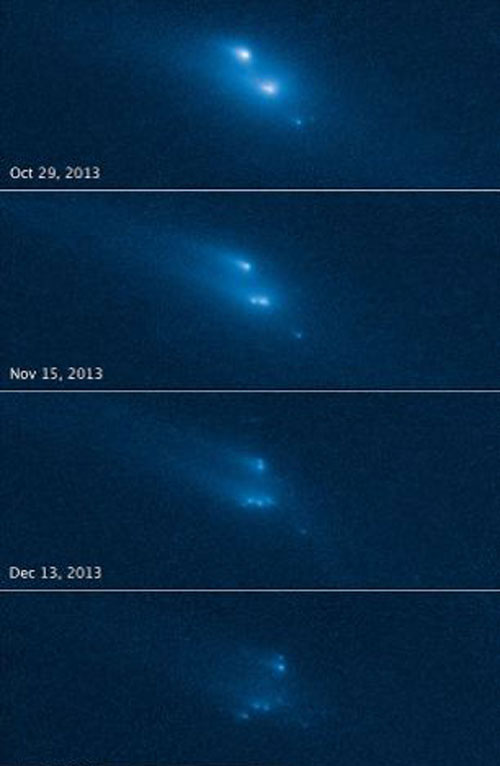Asteroids die
Hubble recorded the self-destruction of a giant meteorite, in an event that was the first to see the Earth's astronomers.
Impressive images show that the self-destruction of a meteorite that lasts for several months was recorded by the Hubble Space Telescope.
The ill-fated asteroid, named P / 2013 R3, was first discovered by Catalina and Pan-STARRS sky survey telescopes on September 15, 2013.

R3 / 2013 asteroids during self-destruct process - (Photo: Hubble / NASA)
Two weeks later, in turn, the Keck telescope in Hawaii (USA) found that it appeared that there were three celestial bodies moving together and being "wrapped" inside a dust curtain that was as wide as Earth.
However, it was not until Hubble entered, that astronomers discovered that the asteroid actually had 10 different pieces, with each part having a tail like a comet.
In particular, the 4 largest pieces are 365m wide.
The report, published in the Astrophysical Journal Letters, shows that the pieces slid away at a speed of 1.6 km / hr, which is not as fast as walking in space.
After the asteroid explodes into 10 small pieces, these fragments will gradually decompose over time.
It is expected that some small pieces will fall into the Earth's atmosphere and turn into meteor shower in the sky.
About the cause of self-destruction, Professor David Jewitt of the University of California in Los Angeles (USA) said that the influence of light has increased the speed of rotation, causing centrifugal force to make asteroids ripped from the side in.
- NASA hangs on the asteroid
- Change candidates for hunting asteroids
- 10 interesting things about asteroids in the solar system
- 4 asteroids are threatening the Earth
- Identify asteroids to lead near Earth
- Four asteroids are flying past the Earth
- Asteroids are about to fly through the earth
- Researchers lost 900 marks of asteroids near Earth
- Map of asteroids in the solar system for nearly 20 years
- Thousands of bombs threaten the life of the earth
- The risk of asteroids stabbing the Earth is higher than expected
- Giant asteroids do not endanger the Earth
 Van Allen's belt and evidence that the Apollo 11 mission to the Moon was myth
Van Allen's belt and evidence that the Apollo 11 mission to the Moon was myth The levels of civilization in the universe (Kardashev scale)
The levels of civilization in the universe (Kardashev scale) Today Mars, the sun and the Earth are aligned
Today Mars, the sun and the Earth are aligned The Amazon owner announced a secret plan to build a space base for thousands of people
The Amazon owner announced a secret plan to build a space base for thousands of people